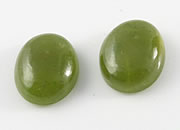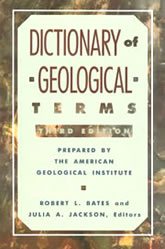Geological Terms Beginning With "V"
For terms beginning with other letters, please click below
|
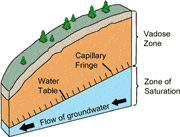
Vadose Water
Water that exists in the pore spaces of a rock or soil within the vadose zone (between the ground surface and the water table).
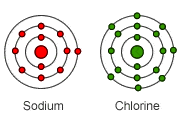
Valence Electrons
Electrons in the outermost shell of an atom. The electrons that are typically involved in making chemical bonds. Shown in the image is one sodium atom and one chlorine atom. A loss or gain of electrons in the outermost shell would produce an ion with a valence.

Valley Glacier
A glacier that occurs in a mountainous region and occupies a valley. Also known as an Alpine Glacier.
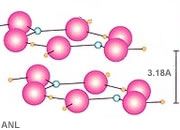
Van der Waals Bond
A weak chemical bond in which atoms are held together by weak electrostatic attraction.
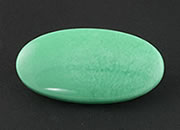
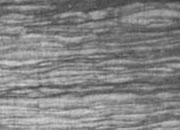
Varve
A thin layer of fine-grained sediment deposited in the still waters of a lake. Varves are frequently associated with glaciation and represent a yearly sedimentation cycle - a silty, light-colored layer deposited in summer and a darker, organic-rich clay layer deposited during winter.
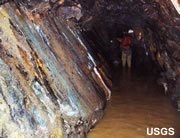
Vein
A fracture that has been filled with mineral material. The photo shows a passage in an underground mine that was developed by removing the rock within a vein that followed a fault. The exposed footwall surface of fault is on the left side of the photo. From the Standard Mine in Gunnison County, Colorado.


Vertical Exaggeration
In making sketches of landscapes and cross sections, the vertical dimension is frequently exaggerated to show topographic detail. Vertical exaggeration is a number that represents the magnitude of this exaggeration. It is a proportion between the vertical scale and the horizontal scale. For example, a cross section with a vertical exaggeration of 4 has a vertical scale that is four times the horizontal scale (in this example the vertical scale could be 1:25 while the horizontal scale is 1:100). The image shows a cross section through a mud volcano created using high-resolution seismic reflection with a vertical exaggeration of 16.5.

Vesicle
Spherical or elongated cavities in an igneous rock that are created when a melt crystallizes with bubbles of gas trapped inside. The image is a piece of pumice, a rock with abundant vesicles.
Vesuvianite
Vesuvianite is a mineral formed by the contact metamorphism of limestone. It is often an attractive translucent green color that reminds people of jade. For that reason, it is often cut into gemstones. Named after Mt. Vesuvius.
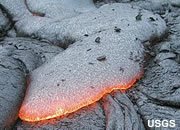
Viscosity
The resistance of a fluid to flow. Fluids with a high viscosity resist flow. Fluids with a low viscosity flow freely. The photo shows a low-viscosity basaltic lava flow which is so hot that the lava is incandescent.

Volcanic Arc
A chain of volcanoes that forms on the surface of a continental plate when an oceanic plate collides with it and subducts beneath it. Also, a chain of volcanoes that forms on an oceanic plate in a similar collision with another oceanic plate. The image shows the Cascades Volcanic Arc of the northwestern United States.
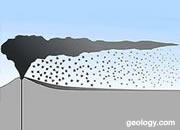
Volcanic Ash
Small particles, less than two millimeters, of igneous rock that form when a spray of liquid magma is blown from a volcanic vent by escaping gas. These cool quickly, usually into tiny glassy particles similar to pumice, which are lifted out of the vent by escaping gas and carried away from the volcano by wind. These particles can be carried in the atmosphere for hundreds to thousands of miles and present a hazard to aircraft. The smallest and most mobile particles are known as "volcanic dust."

Volcanic Ashfall
An accumulation of volcanic ash produced by an eruption. These can be very thick near the vent and decrease to a light dusting in a downwind direction. An ashfall presents a breathing hazard to people and animals. It can also cover crops and ruin harvest. When a significant accumulation occurs, it can collapse buildings, fill storm drains, and turn into a natural "concrete" if it becomes wet. It can be like a snowfall that does not melt and thus creates a disposal problem.

Volcanic Block
A rock greater than 64 millimeters in diameter that was ejected from a volcano during an explosive eruption. They are typically pieces of the volcanic cone that were torn loose during the eruption rather than a mass of molten ejecta that solidified in flight. The block in the photo was found on Kilauea Volcano, Hawaii.

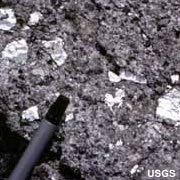
Volcanic Breccia
An igneous rock made up of pyroclastic fragments that are at least 64 millimeters in diameter. The photo shows a specimen of mineralized tuff collected near Spore Mountain, Utah.
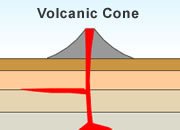
Volcanic Cone
A cone-shaped hill or mountain composed of pyroclastic debris and/or lava that has accumulated around a volcanic vent during eruptions.

Volcanic Dome
A round, steep-sided extrusion of very viscous lava that is squeezed from a volcanic vent without major eruption. The lava is too viscous to flow and is composed of rhyolite or dacite. The dome shown in the photo is the vent of the Novarupta eruption of 1912, the largest volcanic eruption of the 20th century. The small dome was overlooked when the source of the eruption was originally determined, and the wrong volcano was blamed. Also called "lava domes."
|
Dictionary of Geological Terms - Only $19.99 All scientific disciplines have an essential vocabulary that students and professionals must understand to learn and communicate effectively. A geology dictionary that is used regularly is one of the most important tools for developing professional competence. A good dictionary should be on the desk of every geologist and within easy reach. This dictionary is compact and inexpensive at only $19.99. More information. |
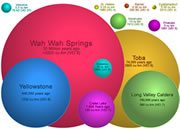
Volcanic Explosivity Index
A method of comparing the severity of explosive volcanic eruptions using the volume of material ejected as a scale. The scale is logarithmic and begins at 0 for an eruption that produces less than 0.001 cubic kilometer of ejecta. Each step in the scale is a 10X increase in the volume of ejecta. About fifty eruptions have been rated a value of 8 on this scale.

Volcanic Neck
A vertical intrusion with the geometry of a volcanic pipe; an erosional remnant of a volcanic pipe. The image is a photo of "Ship Rock," one of the world's best-known volcanic necks, located in San Juan County, New Mexico.
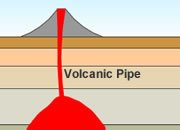
Volcanic Pipe
A vertical or nearly vertical conduit that connects a magma reservoir to the surface. Magma and gas travel upwards through this conduit to produce a volcanic eruption. After the eruption, the pipe can be filled with cooling magma that preserves its shape as an intrusive body, or it can be filled with volcanic breccia and serve as a passageway for liquids, gases, and their entrained solids.
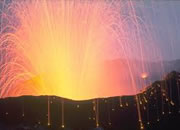

V-shaped valley
A valley with a narrow bottom and a cross section shaped like the letter "V." Valleys of this shape are almost always cut by stream erosion. The photo shows a V-shaped valley cut into the Orange Mountain Basalt near Feltville, New Jersey.
|
| More General Geology |
 |
Fossils |
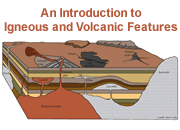 |
Igneous and Volcanic Features |
 |
Geology Dictionary |
 |
Diamonds |
 |
Minerals |
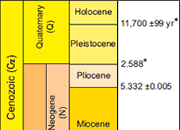 |
Divisions of Geologic Time |
 |
Land Below Sea Level |
 |
Gifts That Rock |

Find Other Topics on Geology.com:

|

| ||

|

| ||

|

| ||

|

|

